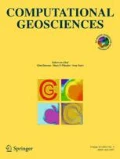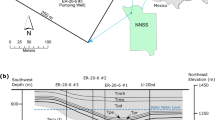Abstract
Geological characterization of naturally fractured reservoirs is potentially associated with large uncertainty. However, the geological modeling of discrete fracture networks (DFN) is considerably disconnected from uncertainty modeling based on conventional flow simulators in practice. DFN models provide a geologically consistent way of modeling fractures in reservoirs. However, flow simulation of DFN models is currently infeasible at the field scale. To translate DFN models to dual media descriptions efficiently and rapidly, we propose a geostatistical approach based on patterns. We will use experimental design to capture the uncertainties in the fracture description and generate DFN models. The DFN models are then upscaled to equivalent continuum models. Patterns obtained from the upscaled DFN models are reduced to a manageable set and used as training images for multiple-point statistics (MPS). Once the training images are obtained, they allow for fast realization of dual-porosity descriptions with MPS directly, while circumventing the time-consuming process of DFN modeling and upscaling. We demonstrate our ideas on a realistic Middle East-type fractured reservoir system.
Similar content being viewed by others
References
Warren, J.E., Root, P.J.: The behavior of naturally fractured reservoirs. Soc. Petr. Eng. J. 3(3), 245–255 (1963). doi:10.2118/426-PA
Dershowitz, B., LaPointe, P., Eiben, T., Wei, L.: Integration of discrete feature network methods with conventional simulator approaches. SPE. Reserv. Eval. Eng. 3(2), 165–170 (2000). doi:10.2118/62498-PA
Cacas, M.C., Daniel, J.M., Letouzey, J.: Nested geological modelling of naturally fractured reservoirs. Pet. Geosci. 7, 43–52 (2001)
Zhong, J., Aydina, A., McGuinness, D.L.: Ontology of fractures. J. Struct. Geol. 31, 251–259 (2009)
Guerriero, V., Iannace, A., Mazzoli, S., Parente, M., Vitale, S., Giorgioni, M.: Quantifying uncertainties in multi-scale studies of fractured reservoir analogues: implemented statistical analysis of scan line data from carbonate rocks. J. Struct. Geol. 32, 1271–1278 (2010)
Caers, J., Zhang, T.: Multiple-point geostatistics: a quantitative vehicle for integrating geologic analogs into multiple reservoir models. In: Grammer, G.M., Harris, P.M., Eberli, G.P. (eds.) Integration of Outcrop and Modern Analogs in Reservoir Modeling, pp 383–394. AAPG, Tulsa (2002)
Strebelle, S.: Conditional simulation of complex geological structures using multiple-point statistics. Math. Geol. 34, 1–21 (2002)
Caers, J., Strebelle, S., Payrazyan, K.: Stochastic integration of seismic data and geologic scenarios: a West Africa submarine channel saga. Lead. Edge 22, 192–196 (2003)
Hu, L.Y., Chugunova, T.: Multiple-point geostatistics for modeling subsurface heterogeneity: a comprehensive review. Water Resour. Res. 44, W11413 (2008)
Daly, C., Caers, J.: Multi-point geostatistics—an introductory overview. First Break 28, 39–47 (2010)
Bond, C.E., Gibbs, A.D., Shipton, Z.K., Jones, S.: What do you think this is? Conceptual uncertainty in geoscience interpretation. GSA Today 17, 4–10 (2007)
Cherpeau, N., Caumon, G., Caers, J., Lévy, B.: Method for stochastic inverse modeling of fault geometry and connectivity using flow data. Math. Geosci. 44, 147–168 (2012)
Feyen, L., Caers, J.: Quantifying geological uncertainty for flow and transport modeling in multi-modal heterogeneous formations. Adv. Water Resour. 29, 912–929 (2006)
Suzuki, S., Caumon, G., Caers, J.: Dynamic data integration for structural modeling: model screening approach using a distance-based model parameterization. Comput. Geosci. 12, 105–119 (2008)
Scheidt, C., Caers, J.: Uncertainty quantification in reservoir performance using distances and Kernel methods—application to a West Africa deepwater turbidite reservoir. SPEJ 14(4), 680–692 (2009). doi:10.2118/118740-PA
Park, H., Scheidt, C., Fenwick, D., Boucher, A., Caers, J.: History matching and uncertainty quantification of facies models with multiple geological interpretations. Comput. Geosci. 17(4), 609–621 (2013). doi:10.1007/s10596-013-9343-5
Bourbiaux, B., Basquet, R., Cacas, M.-C., Daniel, J.-M., Sarda, S.: An integrated workflow to account for multi-scale fractures in reservoir simulation models: implementation and benefits.In: Proceedings of Abu Dhabi International Petroleum Exhibition and Conference (2002)
Souche, L., Astratti, D., Aarre, V., Clerc, N., Clark, A., Al Dayyni, T.N.A., Mahmoud, S.L.: A dual representation of multiscale fracture network modelling: application to a giant UAE carbonate field. First Break 30, 43–52 (2012)
Saleri, N.G., Al-Kaabi, A.O., Muallem, A.S.: Haradh III: a milestone for smart fields. J. Pet. Technol. 58, 28–32 (2006)
Streamsim Technologies: 3DSL user manual V 4.10., San Francisco (2013)
Ehrenberg, S.N., Nadeau, P.H., Aqrawi, A.AM.: A comparison of Khuff and Arab reservoir potential throughout the Middle East. AAPG Bull. 91, 275–286 (2007)
Kazemi, H., Merrill, L.S., Porterfield, K.L., Zeman, P.R.: Numerical simulation of water-oil flow in naturally fractured reservoirs. SPE J. 16(6), 317–326 (1976). doi:10.2118/5719-PA
Nelson, R.: Geologic Analysis of Naturally Fractured Reservoirs, 2nd edn. Gulf Professional Publishing, Oxford (2001)
Zahm, C.K., Hennings, P.H.: Complex fracture development related to stratigraphic architecture: challenges for structural deformation prediction, Tensleep Sandstone at the Alcova anticline, Wyoming. AAPG Bull. 93, 1427–1446 (2009)
Chopra, S., Marfurt, K.J.: Volumetric curvature attributes for fault/fracture characterization. First Break 25, 35–46 (2007)
Narr, W., Schechter, D.S., Thompson, L.B.: Naturally Fractured Reservoir Characterization. Society of Petroleum Engineers, Richardson (2006)
Chopra, S.: Coherence cube and beyond. First Break 20, 27–33 (2002)
Neves, F.A., Zahrani, M.S., Bremkamp, S.W.: Detection of potential fractures and small faults using seismic attributes. Lead. Edge 23, 903–906 (2004)
Gabrielsen, R.H.: Characterization of joints and faults. In: Rock Joints: Proceedings of a Regional Conference of the International Society for Rock Mechanics, Loen, 4-6 June 1990, pp 11–17. Taylor & Francis (Balkema), Rotterdam (1990)
Questiaux, J.-M., Couples, G.D., Ruby, N.: Fractured reservoirs with fracture corridors. Geophys. Prospect. 58, 279–295 (2010)
Dershowitz, W.S., Herda, H.H.: Interpretation of fracture spacing and intensity. In: Tillerson and Wawersik (eds.) The 33rd U.S. Symposium on Rock Mechanics (USRMS), June 3–5, 1992, pp 757–766. American Rock Mechanics Association, Santa Fe, NM, Alexandria (1992)
Golder Associates: FracMan 7.4., Redmond (2012)
Jones, M.A., Pringle, A.B., Fulton, I.M., O’Neill, S.: Discrete fracture network modelling applied to groundwater resource exploitation in southwest Ireland. Geol. Soc. Lond. Spec. 155, 83–103 (1999)
Snow, D.T.: Anisotropie permeability of fractured media. Water Resour. Res. 5, 1273–1289 (1969)
Brown, S.R.: Fluid flow through rock joints: the effect of surface roughness. J. Geophys. Res.: Solid Earth. 92, 1337–1347 (1987)
Renshaw, C.E., Park, J.C.: Effect of mechanical interactions on the scaling of fracture length and aperture. Nature 386, 482–484 (1997)
Oda, M.: Permeability tensor for discontinuous rock masses. Geotechnique 35, 483–495 (1985)
Caers, J.: Modeling Uncertainty in the Earth Sciences. Wiley, Oxford (2011)
Scheidt, C., Caers, J.: Representing spatial uncertainty using distances and kernels. Math. Geosci. 41, 397–419 (2008)
Dubuisson, M.-P., Jain, A.K.: A modified Hausdorff distance for object matching. In: Proceedings of the 12th IAPR International Conference on Pattern Recognition, 1994. Conference A: Computer Vision Image Processing, vol. 1, pp 566–568 (1994)
Maechler, M., Rousseeuw, P., Struyf, A., Hubert, M., Hornik, K.: Cluster: Cluster Analysis Basics and Extensions. R package version 1.14.1 (2011)
R Development Core Team: R: A language and environment for statistical computing. R Foundation for Statistical Computing, Vienna (2011)
Rousseeuw, P.J.: Silhouettes: a graphical aid to the interpretation and validation of cluster analysis. J. Comput. Appl. Math. 20, 53–65 (1987)
Honarkhah, M., Caers, J.: Stochastic simulation of patterns using distance-based pattern modeling. Math. Geosci. 42, 487–517 (2010)
Remy, N., Boucher, A., Wu, J.: Applied Geostatistics with SGeMS: A User’s Guide. Cambridge University Press, Cambridge (2009)
Honarkhah, M., Caers, J.: Direct pattern-based simulation of non-stationary geostatistical models. Math. Geosci. 44, 651–672 (2012)
Lees, J.M.: RFOC: Graphics for Spherical Distributions and Earthquake Focal Mechanisms. R package version 3, 2 (2012)
Author information
Authors and Affiliations
Corresponding author
Rights and permissions
About this article
Cite this article
Jung, A., Fenwick, D.H. & Caers, J. Training image-based scenario modeling of fractured reservoirs for flow uncertainty quantification. Comput Geosci 17, 1015–1031 (2013). https://doi.org/10.1007/s10596-013-9372-0
Received:
Accepted:
Published:
Issue Date:
DOI: https://doi.org/10.1007/s10596-013-9372-0




